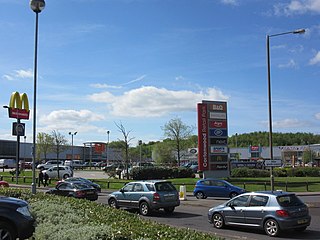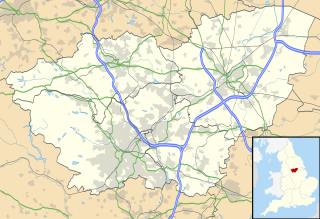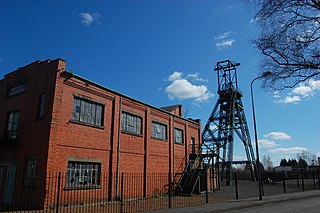Related Research Articles
Agecroft Colliery was a coal mine on the Manchester Coalfield that opened in 1844 in the Agecroft district of Pendlebury, Lancashire, England. It exploited the coal seams of the Middle Coal Measures of the Lancashire Coalfield. The colliery had two spells of use; the first between 1844 and 1932, when the most accessible coal seams were exploited, and a second lease of life after extensive development in the late 1950s to access the deepest seams.

Cortonwood was a colliery near Rotherham, South Yorkshire, England. The colliery's proposed closure was a tipping point in the 1984-85 miner's strike. Today the site is a shopping and leisure centre.

The Maltby Main Colliery was a coal mine located 7 miles (11 km) east of Rotherham on the eastern edge of Maltby, South Yorkshire, England. The mine was closed in 2013.

The Birley Collieries were a group of coal mines set in the Shire Brook Valley in south east Sheffield, South Yorkshire, England. They were connected to the railway system by a branch line from the Manchester, Sheffield and Lincolnshire Railway at Woodhouse East Junction, about 800 yards east of Woodhouse station.
Kilnhurst Colliery, formerly known as either Thrybergh or Thrybergh Hall Colliery, was situated on the southern side of the village of Kilnhurst, near Rotherham, South Yorkshire, England.

Kiveton Park Colliery was a coal mine in the village of Kiveton Park, near Rotherham, South Yorkshire, England.

Barnburgh Main Colliery was a coal mine situated on the outskirts of the village of Barnburgh, about two miles north of Mexborough in the Dearne Valley, South Yorkshire, England. The sinking of the colliery was commenced in 1911 by the Manvers Main Colliery Company of Wath-upon-Dearne.

Thurcroft Colliery was a coal mine situated in the village of Thurcroft, near Rotherham, South Yorkshire, England.
Warren House Colliery was a coal mine situated to the north of Rawmarsh, near Rotherham, South Yorkshire, England.
The Elsecar Collieries were the coal mines sunk in and around Elsecar, a small village to the south of Barnsley in what is now South Yorkshire, but was traditionally in the West Riding of Yorkshire.
The South Yorkshire Coalfield is so named from its position within Yorkshire. It covers most of South Yorkshire, West Yorkshire and a small part of North Yorkshire. The exposed coalfield outcrops in the Pennine foothills and dips under Permian rocks in the east. Its most famous coal seam is the Barnsley Bed. Coal has been mined from shallow seams and outcrops since medieval times and possibly earlier.
Aldwarke Main Colliery was a coal mine sunk in the Don Valley, near Rotherham, South Yorkshire, England.

Rawmarsh is a large village in the Metropolitan Borough of Rotherham, in South Yorkshire, England. Historically within the West Riding of Yorkshire, it is 2 miles (3 km) north-northeast from Rotherham town centre and 3 miles (5 km) south-southwest of Swinton. The village also forms part of the Sheffield Urban Area. The Rawmarsh ward of Rotherham MBC had a population of 13,389 at the 2011 Census. Rawmarsh also contains other output areas from neighbouring wards giving it a population of 18,498 in 2011 and 18,535 in 2014.

Bullcroft Colliery was a coal mine situated by the village of Carcroft north of Doncaster. The Bullcroft Colliery Company was formed in April 1908 and sinking of the shafts commenced immediately. In January 1909, at a depth of 100 feet (30 m), a water course yielding over 1,000 US gallons (3,800 L) per minute was struck, it was capped back and sinking continued but only a month later, at 180 feet (55 m), another water course, big enough to be described as a "subterranean river", was struck - too much for the steam operated pumps to cope with. Electric pumps were brought in to cope with the flow but even with a capability of 6,250 US gallons (23,700 L) per minute they couldn't cope and sinking was stopped so the full situation could be assessed.

The Ingleton Coalfield is in North Yorkshire, close to its border with Lancashire in north-west England. Isolated from other coal-producing areas, it is one of the smallest coalfields in Great Britain.

Astley Green Colliery was a coal mine in Astley, Greater Manchester, then in the historic county of Lancashire, England. It was the last colliery to be sunk in Astley. Sinking commenced in 1908 by the Pilkington Colliery Company, a subsidiary of the Clifton and Kersley Coal Company, at the southern edge of the Manchester Coalfield, working the Middle Coal Measures where they dipped under the Permian age rocks under Chat Moss. The colliery was north of the Bridgewater Canal. In 1929 it became part of Manchester Collieries, and in 1947 was nationalised and integrated into the National Coal Board. It closed in 1970, and is now Astley Green Colliery Museum.

Bradford Colliery was a coal mine in Bradford, Manchester, England. Although part of the Manchester Coalfield, the seams of the Bradford Coalfield correspond more closely to those of the Oldham Coalfield. The Bradford Coalfield is crossed by a number of fault lines, principally the Bradford Fault, which was reactivated by mining activity in the mid-1960s.

Bersham Colliery was a large coal mine located near Rhostyllen in Wrexham County Borough, Wales. The mine accessed seams found in the Denbighshire Coalfield.
The Peckfield pit disaster was a mining accident at the Peckfield Colliery in Micklefield, West Yorkshire, England, which occurred on Thursday 30 April 1896, killing 63 men and boys out of 105 who were in the pit, plus 19 out of 23 pit ponies.

Upton Colliery was a coal mine near to the village of Upton in the West Riding of Yorkshire, England. The site was 8.5 miles (13.7 km) north west of Doncaster and 10 miles (16 km) north east of Barnsley. Coal was transhipped from the colliery by the former Hull and Barnsley Railway line.
References
- Official handbook of Rawmarsh Urban District Council
- Reports of Accident contained in "The Times".